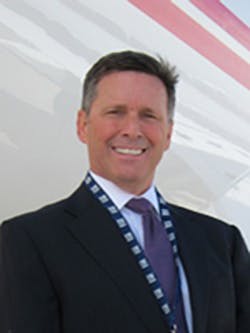New Businesses Help Colorado Springs Airport Grow
Greg Phillips became aviation director of Colorado Springs Airport on Jan. 30, 2017. He came from Colorado’s Eagle County Regional Airport, where he served five years as the executive director of aviation.
Past jobs include airport director for Pangborn Memorial Airport in East Wenatchee, Wash., deputy director of Missoula International Airport and airport manager for the Bend Municipal Airport, where he was named Oregon State Airport Manager of the Year in 2006.
Phillips has an engineering degree from West Point and served as a helicopter pilot and Army Ranger. After leaving the military, he worked as an engineering project manager for Boeing and an engineer and project manager at the FAA’s Airports Division, where he was responsible for public airport construction and grant funding for all of the public airports in Oregon. He also served as the deputy program manager for the FAA project team overseeing the design and construction of Denver International Airport.
In his current job, Phillips manages, plans and direct airport operations, maintenance, construction, economic development, marketing and long-term planning activities. He spoke to Airport Business magazine about the rise, fall and rise of the airport, competition with Denver International Airport, traffic growth in the region and why it has become a magnet for aviation and aerospace businesses.
Airport Business: You came on the job in January. What was so appealing to you about this job?
Greg Phillips: I’ve been in the Northwest mountain region pretty much all my career, so I have always been intrigued and impressed with Colorado. When the Colorado Springs job came open as the second-busiest airport in Colorado, it had a lot of appeal to me. When I started my career in airports after I left the FAA, I made a list of airports I thought might interest me as a career and Colorado Springs was on that list. So I was tickled when the job came open and they were foolish enough to pick me. It’s been fun ever since.
AB: In 1995, Colorado Springs Airport became the home of start-up carrier Western Pacific Airlines. The airport’s traffic grew and it expanded to accommodate that growth. When the airline shut down three years later, how was the airport able to recover?
GP: At that time, Western Pacific, one of, if not the first, ultra-low cost carriers, provided service to 35 cities here. During that time, the airport grew rapidly and it was largely in response to that demand. In the forensics that we’ve done, we were at 2.4 million passengers. So with that, they built the existing terminal and had to build what we call the East Terminal unit, which had an additional four gates.
All that was great at the time, but clearly, it was an unsustainable financial model and sadly, they went bankrupt. Since then, it’s not been a pretty story in Colorado Springs. Some of that coincided with the opening of Denver International Airport and some arm wrestling among the carriers up in Denver about hubbing and pricing. Once those things got settled, that’s when Colorado Springs started to suffer. We couldn’t match the prices at Denver. There’s the larger catchment area and its’ significantly more number of flights. The airlines started to pay more attention to Denver than to Colorado Springs.
AB: In March, Frontier Airlines announced 11 new year-round and seasonal routes in 10 cities across the U.S., including flights to seven cities out of Colorado Springs. Why do you think your airport got so many of those flights?
GP: It’s always hard for an airport to see behind the curtain what’s really going on at an airline. In a conversation with Frontier CEO Barry Biffle, he said ‘I don’t know why anybody from the Centennial on south doesn’t think about Colorado Springs [Airport] first.’ We have advantages including easy entry and exit, quick access to the terminal, lower-priced parking, shorter checkpoint lines, no lines at our concessions and much shorter walks to our gates.
At Denver, you really do need to plan on two hours to get to your gate. I’m not maligning large hubs because they have a huge place in the national airspace system. But for small airports, what we sell is convenience and simplicity. You add to that, a level of customer service that a small airport is capable of providing that is hard for a large hub to match.
By building up the routes and opportunities, particularly from the ultra-low-cost carriers like Allegiant and Frontier, it has put downward price pressure on all the other carriers as well. In fact, the Colorado Springs Gazette did an article looking at the fourth quarter 2016 here and our average fares went down 11 percent. When you talk about that, along with all the great things a small airport has, then all of a sudden, you’ve got a real strong opportunity.
AB: What do you say to people who see you as a competitor to Denver International Airport?
GP: I’m kind of funny because I tend to think that if one airport profits and succeeds, then other airports do too. What is it we’re trying to do? We’re trying to get people traveling and make make it easy for them. Does our leakage go to Denver? Yes it does. But I think there’s enough opportunity across the state for both of us. I just don’t tend to think the same as others do because I think that if Denver succeeds, we have a chance to succeed and if we succeed, hopefully we can compliment Denver as well.
Colorado Springs is never going to beat Denver. We don’t really want to beat Denver. When we did a two-market study in May, we found a catchment area of 7.1 million people looking from the south edge of DIA all the way south. We don’t ever expect that we’d get anybody bypassing DIA to come through Colorado Springs, but that’s still a lot of people.
Our leakage report shows that we’re only getting about 17.8 percent of that, so there’s plenty of opportunity for southern Colorado citizens to use the local airport. As I-25 gets more and more congested between Denver and Colorado Springs, once again, it just continues to make sense to at least consider Colorado Springs as an option, even if you are north of Colorado Springs.
A lot of this relates to our effort to offer more destinations. It’s one thing to say that, but if you only have five destinations, it’s going to be a tough sell. But we have 17 direct destinations right now. A few of them are seasonal, but with that, and with the growth that we continue to promote, we hope it will continue to make it easy for southern Colorado citizens to use the airport.
AB: What construction projects are on the books or being planned?
GP: In August, we opened a new facility for Cutter Aviation FBO. Sierra Nevada Corporation is building a 60,000 square-foot hangar that will open in September. We have a World War II aviation museum and they’ve raised around $12 million for their next expansion.
We have Peterson Air Force Base right here on the airfield. In fact, we’re not technically joint military-civilian, but they are a tenant of the airport. The airport property is actually owned by the city of Colorado Springs. Our agreement with Peterson is that they don’t pay us rent; they provide all our firefighting services. They’ve got 55 fully trained firefighters and they do a fantastic job for us.
AB: Why do you think Colorado Springs Airport has become such an appealing place for aviation-related businesses?
GP: I think having multiple military missions here has something to do with it. The Forest Service has five C-130s that the Air Force donated to them to convert to firefighting. Peterson AFB’s mission is maintaining C-130s. Sierra Nevada Corporation is building a hangar to work on military-mission C-130s. There’s a synergy here that just makes sense. Add to that, we’ve got a 13,501-foot runway that is the fifth-longest in the U.S. You have a transitioning workforce that’s skilled, smart and ready to work hard. I don’t understand why anybody would go anywhere else.
AB: Traffic at the airport rose 10.6 percent in 2016. What’s driving this?
GP: To be fair, much of our commercial inroads have been because of Frontier. They’ve grown, and as a result, when Frontier announced new flights, American responded by initiating twice daily service to Chicago O’Hare. As we’ve had the announcement of the flights and as the flights started and they have low fares, people are looking at Colorado Springs and more people are choosing Colorado Springs. All told, the numbers for most of our other carriers are up too, so we end up with what’s pretty solid growth right now.
AB: What are your goals for the rest of 2017 going into the first half of 2018?
GP: The clear message from our community is more commercial service and that drives many of our actions. We’re continuing to sharpen our focus on air service development and how we utilize our staff and outside consulting, system support and how we communicate with the airlines. It’s something that the big airports are all really good. But smaller airports tend to dedicate fewer resources to it because they just don’t have them.
I want Colorado Springs to be the most aggressive small airport in the country when it comes to air service development because it’s super important. As airport managers, we’ve all become business developers, so it’s important for us to continue to build aerospace and aviation opportunities here and within the community. I’d love to see Colorado Springs be a center of excellence for aerospace and aviation development. We can support that through the incentives that we offer, our commercial aeronautical zone, our enterprise zone and our foreign trade zone. If we’re inviting to aviation-based businesses, we’ll do everything we can to support them.
We have 900 acres of prime land available for non-aeronautical development and we’re putting conceptual plan together for that. Those are things that help spread our revenue base, help ensure stability in up and down times and help us keep our costs down. The last thing for me is customer service. That area again where I think small airports have a lot of opportunity and we intend for Colorado Springs to be a place where we reduce the stress of travel and provide great customer service.
About the Author

